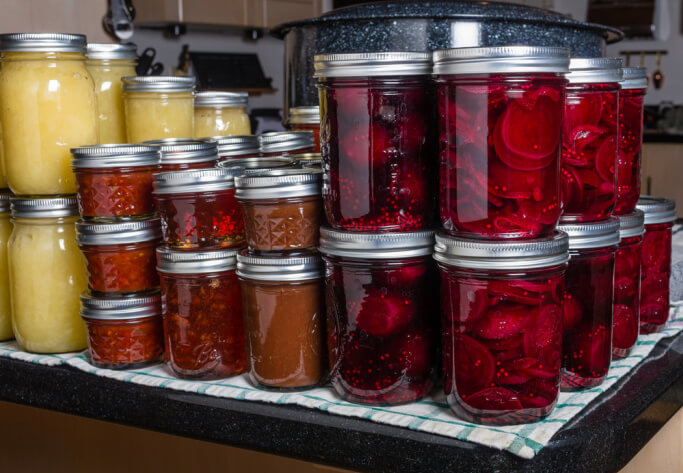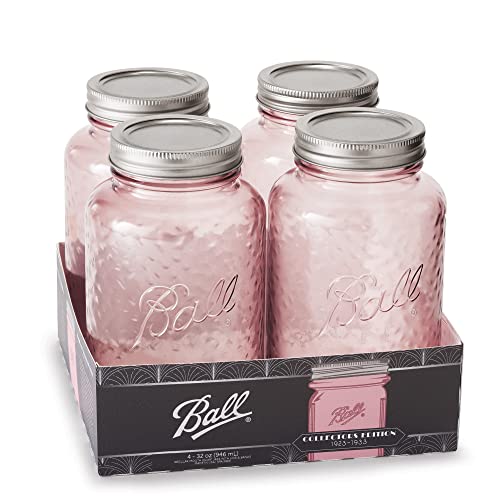The Best Home Canning Supplies and Equipment
Canning your own food at home isn’t as hard or as complicated as you might think! But having the right canning supplies makes all the difference. Here I share some of the very best canning supplies and tools you’ll need to successfully get started with your own home food preservation.

The Best Home Canning Supplies and Equipment
Canning fruits and vegetables from home gardens was a common skill practiced by previous generations.
As home gardens were plentiful, it was taken for granted that families would can all the fresh produce they weren’t able to eat right away.
As part of the World War II “victory gardens” movement, an estimated 20 million home gardens were supplying families with greater than 40% of the produce grown in 1943.
According to one source, “Seven out of ten households (over 24 million) preserved fruits and vegetables in 1944.”
And while recent numbers are hard to come by, about 40% of American households did home canning in the early 1980s.
But isn’t wasn’t only produce that ended up in the canner. Home-canned meats were also popular items to include in home food preservation efforts.
But home food preservation is not only a relic of the distant past. Particularly with rising food prices, more and more people today want to be less reliant on the grocery store.
You could potentially save a lot of money with canning. But another great benefit of preserving produce grown in your own garden or purchased locally is that the quality will be higher with less exposure to all the agricultural chemicals found in pesticide-laden foods.
Maybe it’s just me, but home-canned green beans taste so much better than those from a can purchased at the store!
Affiliate links included below, which means I may make a small commission at no extra cost to you. As an Amazon affiliate I earn from qualifying purchases. Read my disclosure here.
Water Bath Canner
When I first started canning, I started off with a simple water-bath canner.
Water bath canning is considered the simplest type of canning methods, and a great way for beginners to get started with canning.
One of the main differences between water-bath canners and pressure canners is that water-bath canning is used for high-acid foods. This includes foods like pickles, jams, and fruits.
This type of canner is basically just a big pot (usually made of enamel on steel).
To greatly simplify the canning process, with a water-bath canner you place the filled jars inside the canning pot, then heat them in boiling water for a certain period of time until the lids are sealed onto the jars.
TOP PICK WATER-BATH CANNER

VIEW ON AMAZON*Includes 8-piece canning kit
One other type of canner used in place of (or in addition to) water-batch canners is the steam canner. Some people really like these, but I don’t have personal experience using that type of canner.
Water Bath Canning Supplies
In addition to the actual water bath canner, you’ll need a few other supplies to make your canning job easier and successful. While there are other tools besides the ones I mention, these are the minimum needed to properly do canning.
Jar Rack
One of the most important accessories used in water bath canning is a jar rack (also known as a canning rack or trivet).
This rack fits inside the canner and sits on the bottom of the pot. The jars are placed on the rack, which keeps the jars away from the hot bottom of the canner, which could potentially cause them to break.
Jar Lifter
Another important tool you’ll need is a jar lifter.

There are different types of jar lifters, but the one I recommend has grips to allow you to get the best hold on the jars.
Canning Funnel
The next item that’s needed for canning is a canning funnel (sometimes called a jar funnel).
The funnel is used to pour liquids into your canning jars.
It’s useful to have both small and large funnels to use with different sized jars.
I prefer stainless steel funnels but you can also get a plastic funnel that has headspace measurements. This can be useful when you want to be more precise in how full you fill your jars.
Jar Wrench
In order to easily open or tighten your canning jars, a canning jar wrench is another important tool.
These wrenches work with both wide mouth jars and regular mouth jars.

Pressure Canner
While water-bath canners are a popular option for home canning, the second main type of canner is the pressure canner.
As mentioned earlier, water-batch canning is used for high-acid foods while pressure canning is used with low-acid foods. This includes things like most fresh vegetables, some fruits, and meat.
Pressure canning (not to be confused with pressure cookers) may seem more difficult and complicated than water-bath canning.
But it really isn’t that hard once you understand the process and follow some basic safety rules.
As the name suggests, a pressure canner builds up specific levels of pressure inside the pot as it heats up. This pressure causes the lids to tightly seal onto the canning jars.
Pressure canning is the only approved method for canning meats and vegetables. This is due to concerns over bacterial contamination using other canning methods.
Weighted Gauge vs. Dial Gauge Pressure Canners
There are two types of pressure canners, weighted gauge and dial gauge canners.
Weighted gauge canners are easier to use and heavier duty, but also more expensive.
I have this dial gauge pressure canner. One nice thing about this canner is that it can also be used for water-batch canning.
Compared to the other type of pressure canner, these canners have a relatively low price.
TOP PICK PRESSURE CANNER

VIEW ON AMAZON*May also be used as water-bath canner
Dial-gauge pressure canners do have to be tended fairly closely to make sure the pressure stays high enough. They also have gaskets, which occasionally need to be replaced.
If you’re able to get a weighted gauge canner, that would be the best option for a pressure canner.
The All American Pressure Canner is one of the best-known weighted gauge pressure canner models. These units are so durable that they last for decades and can be passed down to future generations.
But if you’re on a more limited budget, a dial gauge canner should work fine for nearly all home canning needs.
Read More About Stocking the Pantry
- The Best Books on Canning and Food Preserving
- Pantry Staples to Always Keep on Hand
- How to Make Flour With a Grain Mill
- Azure Standard for Beginners
Canning Jars
The next canning supplies to look at are the actual canning jars.
You might think this would be a simple thing, but there are a few details that are useful to know about these jars.
Canning Jar Sizes
First, canning jars come in a variety of sizes.
Some of the most popular sizes are half pints, pint jars and quart glass jars.
While those are some of the more common sizes, you can also get 8 ounce jars (known as jelly jars) and 24 ounce jars (pint and half).

Wide Mouth vs Narrow Mouth Canning Jars
In addition to their capacity, canning jars come with two different sized “mouths.”
Wide mouth jars have a bigger opening than the narrow (also known as “regular”) mouth jars.
Wide-mouth jars are easier to fill than the narrow kind, and simpler to clean since you can more easily stick your hand or cleaning instrument inside.
A regular-mouth canning jar is more tapered at the top. Although these can be harder to fill and clean, some people prefer to use narrow-mouth jars.
Canning Jar Brands
Mason jars are the general name given to glass canning jars. These jars got their name from John Mason, who invented this type of jar in the 1850s.
Mason jars are used to describe any jar that is threaded around the mouth to allow for screw-on lids.
For many decades, the Ball canning jars was the most-well known manufacturer of Mason jars.
Ball jars are actually owned and made by the same company that produces Kerr and Bernardin (Canadian brand) jars.
I really like the look of these Ball vintage canning jars!

Canning Lids
To seal your food inside of the canning jar, you’ll need a supply of canning jar lids.
You can get regular-mouth lids for narrow-mouth jars and wide-mouth lids for the wider-mouth jars.
For food safety and to prevent illness like botulism, you can only use the lids one time.
Canning lids have a rubber ring that shrinks and seals onto the glass jar as the jar and lid are heated.
The lids fit inside of canning rings. While lids can only be used once, canning rids can be used multiple types.
Optional Canning Supplies
The canning supplies I’ve covered so far are all necessary in order to do canning.
However, there are also several optional canning supplies. While not absolutely necessary, these items can make the job easier.
Debubbler
As the name suggests, a debubbler (also known as bubble popper) is used to get rid of air bubbles in your jars.
In place of a dedicated debubbling tool, some people just use a wooden stick like a popsicle stick.
Lid Magnet
Another optional canning accessory is a lid magnet, sometimes referred to as a magnetic lid wand.
These magnets are used to remove hot lids from hot water when they are being sterilized.
Food Mill
A food mill is another useful but not totally necessary tool for home food preservation.

Apple Peeler
If you will be processing a lot of apples to make applesauce or canned apples, an apple peeler can be a great help!
We buy a lot of apples during apple season, and use our apple peeler all the time.
Food Chopper
A food chopper can be another very useful device to use for home canning.

Strainer
The last item in my list of optional canning supplies is a strainer.
As the name suggests, food strainers are is used to strain out seeds and pulp to make things like tomato juice.
Canning Books
I previously shared my favorite canning books, so I won’t spend a lot of time on that here.
For the sake of simplicity, here is what I recommend for those new to canning and wanting a good canning book, or just wanting to try out a new canning recipe:
Ball Complete Book of Home Preserving — This is my first pick for the best book on the home-canning method. It’s a revised edition of a long-time classic.

Beginner’s Guide to Canning – The step-by-step instructions are particularly useful to those new to canning and home preservation.
Final Thoughts on Canning Supplies
If you’re looking to get started with canning at home for the first time, I hope this list of canning supplies is helpful to you. Having the right tools really can make all the difference!
Even if you’ve been canning for a long time and consider yourself knowledgeable about food storage, hopefully you’ve learned a thing or two!
Whether you want to put up garden vegetables, fresh fruits, or any number of different foods, you could soon find that the jars of food can really stack up this canning season!
By jumping in and getting started, you could soon join the ranks of home canning enthusiasts.
